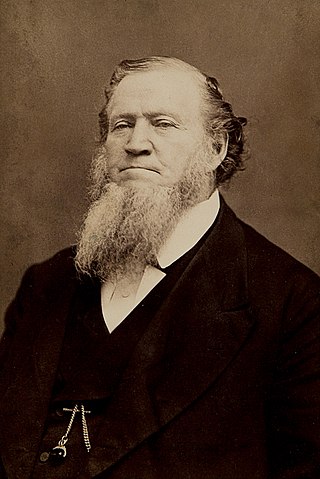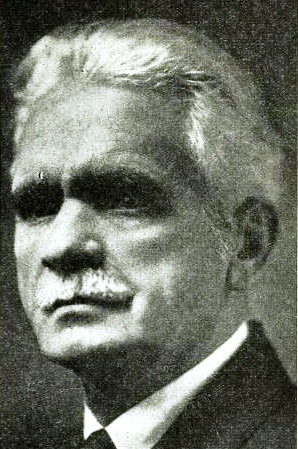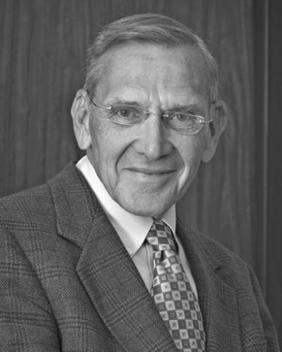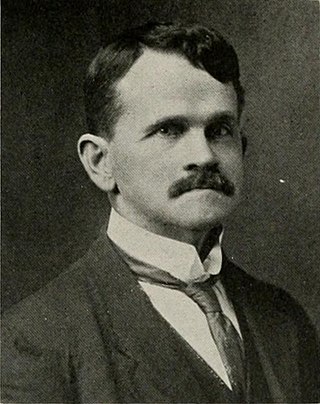
Brigham Young was an American religious leader and politician. He was the second president of the Church of Jesus Christ of Latter-day Saints, from 1847 until his death in 1877. During his time as church president, Young led his followers, the Mormon pioneers, west from Nauvoo, Illinois, to the Salt Lake Valley. He founded Salt Lake City and served as the first governor of the Utah Territory. Young also worked to establish the learning institutions that would later become the University of Utah and Brigham Young University. A polygamist, Young had at least 56 wives and 57 children. He formalized the prohibition of black men attaining priesthood, and led the church in the Utah War against the United States.

Leonard James Arrington was an American author, academic and the founder of the Mormon History Association. He is known as the "Dean of Mormon History" and "the Father of Mormon History" because of his many influential contributions to the field. Since 1842, he was the first non-general authority Church Historian for the Church of Jesus Christ of Latter-day Saints, from 1972 to 1982, and was director of the Joseph Fielding Smith Institute for Church History from 1982 until 1986.

Brigham Henry Roberts was a historian, politician, and leader in the Church of Jesus Christ of Latter-day Saints. He edited the seven-volume History of the Church of Jesus Christ of Latter-day Saints and independently wrote the six-volume Comprehensive History of the Church of Jesus Christ of Latter-day Saints. Roberts also wrote Studies of the Book of Mormon—published posthumously—which discussed the validity of the Book of Mormon as an ancient record. Roberts was denied a seat as a member of United States Congress because of his practice of polygamy.

Hugh Winder Nibley was an American scholar and member of the Church of Jesus Christ of Latter-day Saints who was a professor at Brigham Young University (BYU) for nearly 50 years. He was a prolific author, and wrote apologetic works supporting the archaeological, linguistic, and historical claims of Joseph Smith. He was a member of the LDS Church, and wrote and lectured on LDS scripture and doctrinal topics, publishing many articles in the LDS Church magazines.
Valeen Tippetts Avery was an American biographer and historian of Western American and Latter Day Saint history. With biographer Linda King Newell, she co-authored Mormon Enigma: Emma Hale Smith, a biography of the wife of the founder of the Church of Jesus Christ of Latter-day Saints, Joseph Smith.
John Woodland "Jack" Welch is a scholar of law and religion. Welch is a member of the Church of Jesus Christ of Latter-day Saints and currently teaches at the J. Reuben Clark Law School (JRCLS) at Brigham Young University (BYU) in Provo, Utah, where he is the Robert K. Thomas University Professor of Law. He is notable for his contributions to LDS (Mormon) scholarship, including his discovery of the ancient literary form chiasmus in the Book of Mormon.
Fred Emmett Woods IV is a Brigham Young University professor of Latter-day Saint Church History and Mormon Doctrine, an author specializing in Mormon migration and the Globalization of Mormonism.
The largest church within Mormonism, The Church of Jesus Christ of Latter-day Saints, takes no official position on whether or not biological evolution has occurred, or on the validity of the modern evolutionary synthesis as a scientific theory. In the 20th century, the LDS Church published doctrinal statements on the origin of man and creation. In addition, individual leaders of the LDS Church have expressed a variety of opinions on evolution, many of which have affected the beliefs and perceptions of Latter-day Saints.

Ronald Davis Bitton was a charter member and president of the Mormon History Association, professor of history at the University of Utah, and official Assistant Church Historian in the Church of Jesus Christ of Latter-day Saints working with Leonard J. Arrington.
Brigham Young University Press was the university press of Brigham Young University (BYU).
Noel Beldon Reynolds is an American political scientist and an emeritus professor of political science at Brigham Young University (BYU), where he has also served as an associate academic vice president and as director for the Foundation for Ancient Research and Mormon Studies (FARMS). He was a member of the BYU faculty from 1971 to 2011. He has also written widely on the theology of the Church of Jesus Christ of Latter-day Saints, of which he is a member.
Arnold Kent Garr was the chair of the department of Church History and Doctrine at Brigham Young University (BYU) from 2006 to 2009. He was also the lead editor of the Encyclopedia of Latter-day Saint History.
James Brown Allen is an American historian of Mormonism and was an official Assistant Church Historian of the Church of Jesus Christ of Latter-day Saints from 1972 to 1979. While working as Assistant Church Historian, he co-authored The Story of the Latter-day Saints with Glen Leonard. After Ezra Taft Benson dismissed the book as secular new history, other events led to the dissolution of the LDS Church History department in 1982. Allen resigned as Assistant Church Historian in 1979, returning to work at Brigham Young University (BYU) full-time.
Edward Lawrence Kimball was an American scholar, lawyer, and historian who was a law professor at Brigham Young University (BYU).
The Religious Studies Center (RSC) is the research and publishing arm of Religious Education at Brigham Young University (BYU), sponsoring scholarship on the culture, history, scripture, and doctrine of the Church of Jesus Christ of Latter-day Saints. The dean of Religious Education serves as the RSC's director, and an associate dean oversees the two branches of the RSC: research and publications.

Ronald Warren Walker was an American historian of the Latter Day Saint movement and a professor at Brigham Young University (BYU) and president of the Mormon History Association. His work, acclaimed by the Mormon History Association, dealt with the Godbeites, the Utah War, and the Mountain Meadows Massacre, among other topics.
Mormon studies is the interdisciplinary academic study of the beliefs, practices, history and culture of individuals and denominations belonging to the Latter Day Saint movement, a religious movement associated with the Book of Mormon, though not all churches and members of the Latter Day Saint movement identify with the terms Mormon or Mormonism. Denominations of the Latter Day Saint movement include the Church of Jesus Christ of Latter-day Saints, by far the largest, as well as the Community of Christ (CoC) and other smaller groups, include some categorized under the umbrella term Mormon fundamentalism.

The Church of Jesus Christ of Latter-day Saints was established in Japan in 1901 when the church's first missionaries arrived on August 12. Among them was Heber J. Grant, who was then a member of the Quorum of the Twelve and later became the church's 7th president. Horace S. Ensign, Louis A. Kelsch, and Alma O. Taylor accompanied Grant. The LDS Church's first baptism in Japan was on March 8, 1902, when Grant baptized Hajime Nakazawa, a former Kannushi. The Book of Mormon was translated three times. The first translation, which took over six years, was completed by Taylor in 1909. It was then recommended that the Book of Mormon be translated into bunshō, a more elegant literary style, which was done by Chōkō Ikuta in 1909, shortly before it was published and distributed. The third translation in 1957 was done by Tatsui Sato. In 1995, the Book of Mormon was translated again into a more colloquial style.

William Henry Chamberlin Jr. was an American Mormon philosopher, theologian, and educator. His teachings and writings worked to reconcile Mormonism with the theory of evolution. He taught philosophy and ancient languages as well as science and math at several Latter-day Saints (LDS) institutions including Brigham Young University in the early 20th century. He was one of four educators at Brigham Young University whose teaching of evolution and attempts to reconcile it with Mormon thought, although strongly popular with students, generated controversy among university officials and the LDS community. Chamberlin has been called "Mormonism's first professionally trained philosopher and theologian."

The 1911 modernism controversy at Brigham Young University was an episode involving four professors at Brigham Young University (BYU), who between 1908 and 1911 widely taught evolution and higher criticism of the Bible, arguing that modern scientific thought was compatible with Christian and Mormon theology. The professors were popular among students and the community but their teachings concerned administrators, and drew complaints from stake presidents, eventually resulting in the resignation of all four faculty members, an event that "leveled a serious blow to the academic reputation of Brigham Young University—one from which the Mormon school did not fully recover until successive presidential administrations."








